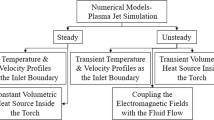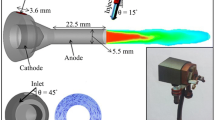Abstract
A comprehensive model was developed to investigate the suspension spraying for a radio frequency (RF) inductively coupled plasma torch. Firstly, the electromagnetic field is solved with the Maxwell equations and validated by the analytical solutions. Secondly, the plasma field with different power inputs is simulated by solving the governing equations of the fluid flow coupled with the RF heating. Then, the suspension droplets embedded with nano particles are modeled in a Lagrangian manner, considering feeding, collision, heating and evaporation of the suspension droplets, as well as tracking, acceleration, melting and evaporation of the nano or agglomerate particles. The non-continuum effects and the influence of the evaporation on the heat transfer are considered. This particle model predicts the trajectory, velocity, temperature and size of the in-flight nano- or agglomerate particles. The effects of operating conditions and intial inputs on the particle characteristics are investigated. The statistical distributions of multiple particles’ size, velocity, temperature are also discussed for the cases with and without consideration of suspension droplets collision.














Similar content being viewed by others
Abbreviations
- A :
-
Magnetic vector potential (A H m−1)
- B :
-
Magnetic flux density (T)
- C p :
-
Specific heat (J kg−1 K−1)
- C D :
-
Drag coefficient
- D :
-
Diffusion coefficients (m2 s−1)
- E :
-
Electric field (V m−1)
- f :
-
Frequency (Hz)
- F :
-
Lorentz force (N m−3)
- H :
-
Magnetic field (A m−1)
- h :
-
Heat transfer coefficient
- J :
-
Current density (A m−2)
- Kn :
-
Knudsen number
- k :
-
Thermal conductivity (W m−1 K−1)
- L m :
-
Latent heat of fusion (J kg−1)
- L v :
-
Latent heat of evaporation (J kg−1)
- m :
-
Mass
- Nu :
-
Nusselt number
- Pr :
-
Prandtl number, Pr = ν/α
- Q J :
-
Joule heating (W m−3)
- Q conv :
-
Convection heat (W m−3)
- Q rad :
-
Radiation heat loss (W m−3)
- Q vap :
-
Vaporization heat (W m−3)
- R :
-
Radius (nm)
- Sh :
-
Sherwood number
- r :
-
Radial coordinate (m)
- t :
-
Time (s)
- T :
-
Particle temperature (K)
- V, U, W:
-
Velocity vector (m s−1)
- x :
-
Axial coordinate (m)
- η :
-
Viscosity (kg s−1 m−1)
- θ :
-
Azimuthal coordinate
- θ inject :
-
Injection angle
- μ 0 :
-
Permeability in vacuum, 4π × 10−7 (H m−1)
- σ :
-
Electrical conductivity S (m−1)
- ω:
-
Angular frequency rad (s−1)
- c :
-
Cell
- f :
-
Film surrounding particle surface
- w :
-
Vicinity of the particle surface
- l :
-
Liquid
- g :
-
Gas
- p :
-
Particle
- so :
-
Solid
- sl :
-
Solvent
- v :
-
Vapor
References
Bouyer E, Gitzhofer F, Boulos MI (1997) Suspension plasma spraying for hydroxyapatite powder preparation by RF plasma. IEEE Trans Plasma Sci 25:1066
Bouyer E, Schiller G, Muller M, Henne RH (2001) Thermal plasma chemical vapor deposition of Si-based ceramic coatings from liquid precursors. Plasma Sources Sci Technol 21:523
Kumar R, Cheang P, Khor KA (2003) Radio frequency (RF) suspension plasma sprayed ultra-fine hydroxyapatite (HA)/zirconia composite powders. Biomaterials 24:2611
Ravi BG, Ashutosh Gandhi S, Guo XZ, Margolies J, Sampath S (2008) Liquid precursor plasma spraying of functional materials: a case study for yttrium aluminum garnet (YAG). J Therm Spray Technol 17:82
Fauchais P, Etchart-Salas R, Rat V, Coudert JF, Caron N, Wittmann-Teneze K (2008) Parameters controlling liquid plasma spraying: solutions, sols, or suspensions. J Therm Spray Technol 17:31
Buchner P, Schubert H, Uhlenbusch J, Weiss M (2001) Evaporation of zirconia powders in thermal radio-frequency plasma. J Therm Spray Technol 10:666
Buchner P, Ferfers H, Schubert H, Uhlenbusch J (1997) Evaporation of copper powders in an inductively coupled thermal rf plasma—numerical modelling and spectroscopic measurements. Plasma Sources Sci Technol 6:450
Bhatia T, Ozturk A, Xie L, Jordan EH, Cetegen BM, Gell M, Ma X, Padture NP (2002) Mechanisms of ceramic coating deposition in solution-precursor plasma spray. J Mater Res 17(9):2363
Tsunekawa Y, Hiromura M, Okumlya M (2000) Nitride formation in synthesis of Titanium Aluminide matrix composite coatings by reactive RF plasma spraying. J Therm Spray Technol 9(1):83
Devi PS, Lee Y, Margolis J, Parise JB, Sampath S, Herman H, Hanson JC (2002) Comparison of citrate-nitrate gel combustion and precursor plasma spray processes for the synthesis of yttrium aluminum garnet. J Mater Res 17(11):2846
Boulos MI (1992) RF induction plasma spraying: state-of-the-art review. J Therm Spray Tech 36(1):33
Mostaghimi J, Proulx P, Boulos MI (1987) A two-temperature model of the inductively coupled rf plasma. J Appl Phys 61(5):1753
Xue S, Proulx P, Boulos MI (2001) Extended-field electromagnetic model for inductively coupled plasma. J Phys Appl D 34:1897
Mostaghimi J, Proulx P, Boulos MI (1984) Parametric study of the flow and temperature fields in an inductively coupled r.f. plasma torch. Plasma Chem Plasma Process 4(3):199
Ye R, Proulx P, Boulos MI (1999) Turbulence phenomena in the radio frequency induction plasma torch. Int J Heat Mass Transfer 42:1585
Selezneva SE, Boulus MI (2001) Supersonic induction plasma jet modeling. Nucl Instrum Methods Phys Res B 180:306
Boulos MI, Gauvin WH (1974) Powder processing in a plasma jet, a proposed model. Can J Chem Eng 52:355
Boulos MI (1978) Heating of powders in the fire ball of an induction plasma. IEEE Trans Plasma Sci 93
Yoshida T, Akashi K (1977) Particle heating in a radio-frequency plasma torch. J Appl Phys 48:2252
Proulx P, Mostaghimi J, Boulos MI (1985) Plasma-particle interaction effects in induction plasma modeling under dense loading conditions. Int J Heat Mass Trans 28:1327
Tanaka Y, Sakuta T (2002) Chemically non-equilibrium modeling of N2 thermal ICP at atmospheric pressure using reaction kinetics. J Phys Appl D 35:468
Shigeta M, Sato T, Nishiyama H (2004) Computational simulation of a particle-laden RF inductively coupled plasma with seeded potassium. Int J Heat Mass Transf 47:707
Shigeta M, Watanabe T (2007) Multi-component co-condensation model of Ti-based boride/silicide nanoparticle growth in induction thermal plasmas. Thin Solid Film 515:4217
Benson CM, Zhong JQ, Gimelshein SF, Levin DA (2003) Simulation of droplet heating and desolvation in inductively coupled plasma—part II: coalescence in the plasma. Spectrochim Acta Part B 58:1453
Shan Y, Mostaghimi J (2005) Modelling of injection of dense liquid sprays in radio frequency inductively coupled plasmas. Plasma Chem Plasma Process 25:193
Fazilleau J, Delbos C, Rat V, Coudert JF, Fauchais P, Pateyron B (2006) Phenomena involved in suspension plasma spraying Part 1 suspension injection and behavior. Plasma Chem Plasma Process 26:371
Marchand C, Chazelas C, Mariaux G, Vardelle A (2007) Liquid precursor plasma spraying: modeling the interactions between the Transient Plasma Jet and the droplets. J Therm Spray Technol 16:5
Xiong Hong-Bing, Lin Jian-Zhong (2009) Nanoparticles modeling in axially injection suspension plasma spray of zirconia and alumina ceramics. J Therm Spray Technol 8:887
Xiong Hong-Bing, Zheng Li-Li, Streibl Tilo (2006) A critical assessment of particle temperature distributions during plasma spraying: numerical studies for YSZ. Plasma Chem Plasma Process 26:53
Cai M, Haydar DA, Montaser A, Mostaghimi J (1997) Computer simulation of argon-nitrogen and argon-oxygen inductively coupled plasmas. Spectrochim Acta Part 52:369
Wan YP, Prasad V, Wang G-X, Sampath S, Fincke JR (1999) Model and powder particle heating, melting, resolidification, and evaporation in plasma spraying processes. J Heat Transf 121:691
Chen X, Pfender E (1983) Effect of the Knudsen number on heat transfer to a particle immersed into a thermal plasma. Plasma Chem Plasma Process 3:97
Ko GH, Ryou HS (2005) Droplet collision processes in an inter-spray impingement system. J Aerosol Sci 36:1300
Patankar SV (1980) Numerical fluid flow and heat transfer. Hemisphere, New York
Davises J (1979) Induction heating handbook. McGraw Hill, London
O’Rourke PJ (1981) Collective drop effects on vaporizing liquid sprays. Ph.D. thesis, Mechanical and aerospace engineering. Princeton University, USA
Acknowledgments
This work was supported by a grant from the Major State Basic Research Development Program of China (973 Program) under contract No. 2011CB706501, the National Natural Science Foundation of China with Grant No. 11072216 and No. 11002136.
Author information
Authors and Affiliations
Corresponding author
Rights and permissions
About this article
Cite this article
Qian, L., Lin, J. & Xiong, H. Numerical Modeling in Radio Frequency Suspension Plasma Spray of Zirconia Powders. Plasma Chem Plasma Process 30, 733–760 (2010). https://doi.org/10.1007/s11090-010-9247-2
Received:
Accepted:
Published:
Issue Date:
DOI: https://doi.org/10.1007/s11090-010-9247-2




